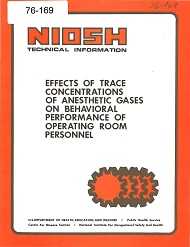Effects of Trace Concentrations of Anesthetic Gases on Behavioral Performance of Operating Room Personnel
April 1976
DHHS (NIOSH) Publication Number 76-169

The effects of trace concentrations of anesthetic gases on behavioral performance were studied in humans. Twenty male volunteers, 20 to 30 years old, were exposed to 25, 50 or 500 parts per million (ppm) nitrous-oxide (10024972) and/or 0.5, 1.0, or 10ppm halothane (151677) for 4 hours. During exposure the subjects completed a battery of seven tests that measured visual acuity, intellectual ability, manual dexterity, vigilance, and the ability to recall series of numbers in normal or reverse order (digit span test). Exposure to nitrous-oxide alone at concentrations of 50ppm or higher or to 50ppm nitrous-oxide plus 0.5, 1.0, or 10ppm halothane significantly impaired performance on the visual acuity and digit span tests and a divided attention task in the visual acuity battery. Performance on tests of intellectual ability was only marginally affected. Exposure to 25ppm nitrous-oxide plus 0.5ppm halothane did not cause any significant performance decrements. The authors suggest that the performance of an anesthetist could be adversely affected by exposure to trace concentrations of anesthetic gases. Operating room scavenging systems should be employed to maintain concentrations of nitrous-oxide and halothane below 25 and
- Page last reviewed: March 31, 2017
- Page last updated: March 31, 2017
- Content source:
- National Institute for Occupational Safety and Health Education and Information Division


 ShareCompartir
ShareCompartir